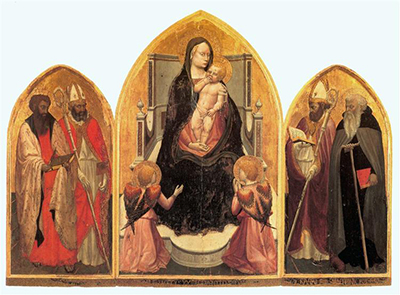The captivating illustration of the San Giovenale Triptych is by the Early Renaissance artist, Masaccio
The famous artist came about in the 15th century as he showcased an array of fresco murals throughout Italy depict religious scenes and figures.
The grand painting witnessed on the left is a three figure alter piece that Masaccio was commissioned to create by an Italian family called the Florentines. The art piece dated back to 1422 and is painted on a wood surface through a fresco style.
The picture in the middle of the Virgin Mary with her child is often known regarded to as San Giovenale Triptych Central Panel. This section showcases the blessed figure with her child Jesus within her arms. The floor boards of the artwork are green, a classic Italian characteristic showcased in an array of Renaissance paintings as the floors were commonly this colour.
The Madonna's cloak falls towards the floor in a deep colour as if hugs her body, not overpowered with detail. MasaccioÕs incredible mastery did not require his artwork to be covered in decorative colours or styles.
The throne at which the virgin figure sits is carved out of a while marble, and lightly decorated with thin gold linings. This incredible attention to detail brings the artwork to life as the viewer is seized by the style. Even though Masaccio is an artist from such an early time period, he had portrayed the characters within his paintings through a realist lens.
The classic gold colour fills the background of the central panel adding the affluent feel to the artwork, and wealth to the building itself.
The left panel of the altarpiece is considered by art critics and historians as the weakest section of the three, due to its blurry technique that takes away from the detail. The section showcases two prominent Saints, St. Bartholomew and St. Blaise. These figures are both drenched in colours of red and gold as their attire compliments one another.
Their bodies are slightly tilted towards the right in order to face the Virginia Mary and her Child in honour. The artist displayed their holy presence by painting a halo around their heads in a golden colour. The background of the artwork continued in the bronze theme presented throughout the altarpiece.
The right panel of the artwork illustrates two prominent Saints as they stand near one another. The left and right panels reflect one another as both showcase two male figures with their body slightly tilted towards the centre. The painting on the right is often referred to as San Giovenale Triptych Right Panel.
The Saint on the right is dressed in a deep black and grey cloak, as he holds a tall wooden stick. His characteristics include a long grey beard, and white hair gently balding. The man does not seem to resemble a holy figure based on his attire, however the aurora around his head indicates his saintly presence. The man holds a red book beneath his left hand, as it is covered in gold pages and pompadour gems around the surface.
To the left of the Saint, his colleague stands as he is engulfed within his book reading it while holding his religious stick. The figure is dressed more luxuriously with a deep red cape that is outlined through gold detailing. The religious power of the man is showcased as he wears white gloves, highly resembling a bishop.
The interesting elements to noticed within the artwork is the dark fabric that Mother Mary is clothed in, differing from the classic red and blue textiles she is portrayed in, within both MasaccioÕs work, and other Renaissance artists. It is highly likely that Masaccio had depicted the Saint on the right of the right panel is dark attire in order to create unity between the dark colours of Mother Mary's clothing.




